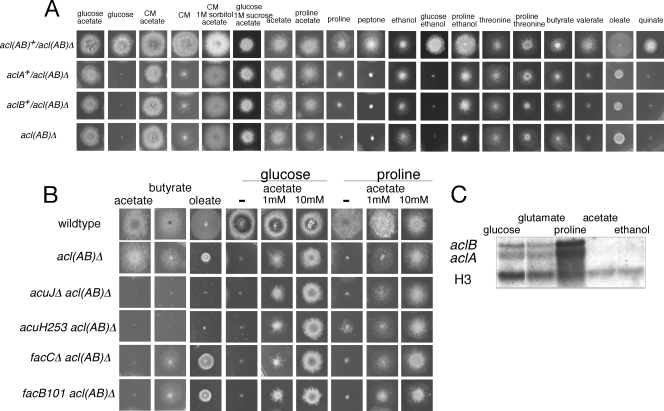Fig. 4.
Deletion of the aclA or aclB gene results in a requirement for cytoplasmic acetyl-CoA. (A) Growth on various carbon sources for 2 to 3 days at 37°C. The following carbon sources (concentrations shown in parenthese) were added to minimal medium with 10 mM ammonium chloride as the nitrogen source: glucose (1%); peptone (0.24%); acetate and proline (50 mM); ethanol (0.5%); quinate (0.25%); butyrate, valerate, and oleate (5 mM); threonine (20 mM). CM, complete medium containing 1% glucose. (B) Repair of acl(AB)Δ in mutant backgrounds affected in acetyl-CoA metabolism. Media were as for panel A, with acetate added at the indicated concentrations (with a dash indicating no added acetate). (C) Northern blot analysis of aclA and aclB expression. RNA was extracted from wild-type mycelia grown for 16 h in 1% glucose medium and then transferred to minimal medium containing 1% glucose, 50 mM glutamate, 50 mM proline, 50 mM acetate, or 0.5% ethanol as the sole carbon source, with 10 mM ammonium chloride as the nitrogen source for 4 h before harvesting and extraction. Ten micrograms of total RNA was run on a 1.2% agarose–formaldehyde gel, blotted, and probed sequentially with 32P-labeled PCR products of aclA (primers 5′-CCAACACTCACAACCCTCCT-3′ and 5′-GTTGAGGCCGAGTTCTTCAC-3′) and aclB (primers 5′-GTTGAGGCCGAGTTCTTCAC-3′ and 5′-ATGCCCTCTTCCACAACAAG-3′), with the EcoRI fragment of the histone H3 gene as a loading control.

